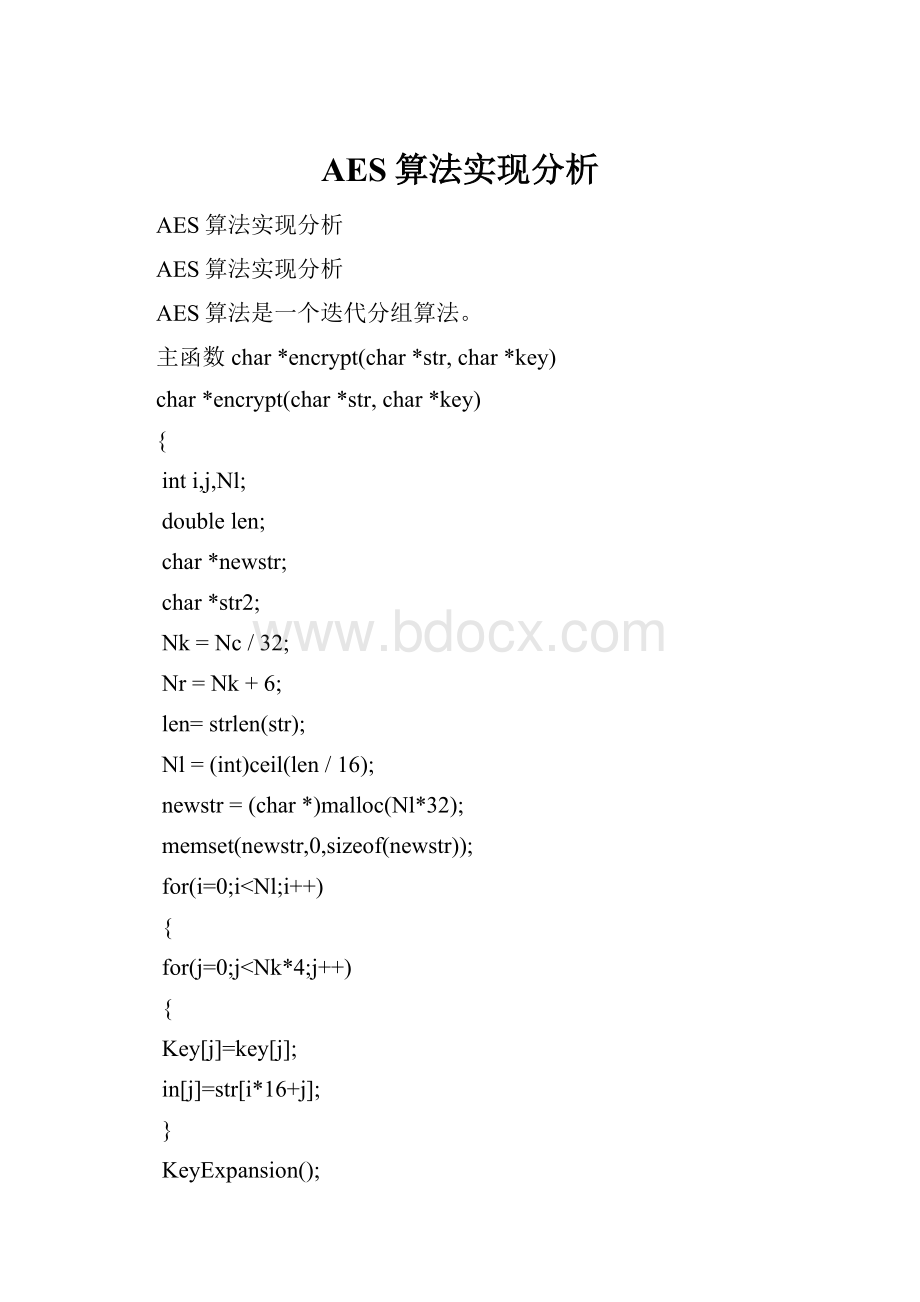 AES算法实现分析.docx
AES算法实现分析.docx
- 文档编号:30625490
- 上传时间:2023-08-18
- 格式:DOCX
- 页数:16
- 大小:65.80KB
AES算法实现分析.docx
《AES算法实现分析.docx》由会员分享,可在线阅读,更多相关《AES算法实现分析.docx(16页珍藏版)》请在冰豆网上搜索。

AES算法实现分析
AES算法实现分析
AES算法实现分析
AES算法是一个迭代分组算法。
主函数char*encrypt(char*str,char*key)
char*encrypt(char*str,char*key)
{
inti,j,Nl;
doublelen;
char*newstr;
char*str2;
Nk=Nc/32;
Nr=Nk+6;
len=strlen(str);
Nl=(int)ceil(len/16);
newstr=(char*)malloc(Nl*32);
memset(newstr,0,sizeof(newstr));
for(i=0;i { for(j=0;j { Key[j]=key[j]; in[j]=str[i*16+j]; } KeyExpansion(); Cipher(); strcat(newstr,out); } returnnewstr; } 该函数需要传入两个参数,明文str和秘钥key。 各个不同的变换都在称为状态(代码中的state数组)的中间结果上运算(见voidCipher()),状态定义为一个4行的字节矩阵,其列数记为Nb,Nb=分组长度/32。 密钥也采用类似的方式用4行的字节矩阵表示,该矩阵的列数记为Nk,Nk=密钥长度/32。 AES密码的加密轮数是和秘钥长度有关的,准确地说,其轮数由Nb和Nk决定,如下表: 传入之后,首先计算明文的长度len,由len/16得到密文应分为多少个8*16=128位的块。 对每个块,进行加密操作Cipher(),加密操作的结果会保存在数组out中,并与最终的密文newstr连接。 下面首先分析加密操作Cipher。 加密voidCipher() voidCipher() { inti,j,round=0; //CopytheinputPlainTexttostatearray. for(i=0;i<4;i++) { for(j=0;j<4;j++) { state[j][i]=in[i*4+j]; } } //AddtheFirstroundkeytothestatebeforestartingtherounds. AddRoundKey(0); //TherewillbeNrrounds. //ThefirstNr-1roundsareidentical. //TheseNr-1roundsareexecutedintheloopbelow. for(round=1;round { SubBytes(); ShiftRows(); MixColumns(); AddRoundKey(round); } //Thelastroundisgivenbelow. //TheMixColumnsfunctionisnothereinthelastround. SubBytes(); ShiftRows(); AddRoundKey(Nr); //Theencryptionprocessisover. //Copythestatearraytooutputarray. for(i=0;i<4;i++) { for(j=0;j<4;j++) { out[i*4+j]=state[j][i]; } } } 首先,将第一轮的秘钥加入(与状态异或)。 AddRoundKey(0); 对于前Nr-1论,每一轮进行如下操作: 字节代替SubBytes(); 行移位ShiftRows(); 列混合MixColumns(); 密钥轮加AddRoundKey(round); 对于最后一轮,只需要进行 字节代替SubBytes() 行移位ShiftRows() 密钥轮加AddRoundKey(round); 然后将存储在state中的密文复制到out中。 下面详细看加密中的每一轮的操作。 字节代替voidSubBytes()及intgetSBoxValue(intnum) voidSubBytes() { inti,j; for(i=0;i<4;i++) { for(j=0;j<4;j++) { state[i][j]=getSBoxValue(state[i][j]); } } } intgetSBoxValue(intnum) { intsbox[256]={ //0123456789ABCDEF 0x63,0x7c,0x77,0x7b,0xf2,0x6b,0x6f,0xc5,0x30,0x01,0x67,0x2b,0xfe,0xd7,0xab,0x76, 0xca,0x82,0xc9,0x7d,0xfa,0x59,0x47,0xf0,0xad,0xd4,0xa2,0xaf,0x9c,0xa4,0x72,0xc0, 0xb7,0xfd,0x93,0x26,0x36,0x3f,0xf7,0xcc,0x34,0xa5,0xe5,0xf1,0x71,0xd8,0x31,0x15, 0x04,0xc7,0x23,0xc3,0x18,0x96,0x05,0x9a,0x07,0x12,0x80,0xe2,0xeb,0x27,0xb2,0x75, 0x09,0x83,0x2c,0x1a,0x1b,0x6e,0x5a,0xa0,0x52,0x3b,0xd6,0xb3,0x29,0xe3,0x2f,0x84, 0x53,0xd1,0x00,0xed,0x20,0xfc,0xb1,0x5b,0x6a,0xcb,0xbe,0x39,0x4a,0x4c,0x58,0xcf, 0xd0,0xef,0xaa,0xfb,0x43,0x4d,0x33,0x85,0x45,0xf9,0x02,0x7f,0x50,0x3c,0x9f,0xa8, 0x51,0xa3,0x40,0x8f,0x92,0x9d,0x38,0xf5,0xbc,0xb6,0xda,0x21,0x10,0xff,0xf3,0xd2, 0xcd,0x0c,0x13,0xec,0x5f,0x97,0x44,0x17,0xc4,0xa7,0x7e,0x3d,0x64,0x5d,0x19,0x73, 0x60,0x81,0x4f,0xdc,0x22,0x2a,0x90,0x88,0x46,0xee,0xb8,0x14,0xde,0x5e,0x0b,0xdb, 0xe0,0x32,0x3a,0x0a,0x49,0x06,0x24,0x5c,0xc2,0xd3,0xac,0x62,0x91,0x95,0xe4,0x79, 0xe7,0xc8,0x37,0x6d,0x8d,0xd5,0x4e,0xa9,0x6c,0x56,0xf4,0xea,0x65,0x7a,0xae,0x08, 0xba,0x78,0x25,0x2e,0x1c,0xa6,0xb4,0xc6,0xe8,0xdd,0x74,0x1f,0x4b,0xbd,0x8b,0x8a, 0x70,0x3e,0xb5,0x66,0x48,0x03,0xf6,0x0e,0x61,0x35,0x57,0xb9,0x86,0xc1,0x1d,0x9e, 0xe1,0xf8,0x98,0x11,0x69,0xd9,0x8e,0x94,0x9b,0x1e,0x87,0xe9,0xce,0x55,0x28,0xdf, 0x8c,0xa1,0x89,0x0d,0xbf,0xe6,0x42,0x68,0x41,0x99,0x2d,0x0f,0xb0,0x54,0xbb,0x16}; returnsbox[num]; } 字节代替的操作本身是一个简单的查表操作,将输入的16位密文作为下标,查找到S盒中对应的数据即可state[i][j]=getSBoxValue(state[i][j]);也即state[i][j]=sbox[i][j];。 代码中直接给出了S盒,不过实际上,S盒的构造却比较复杂,用到了字节在在有限域GF(2^8)中的逆以及矩阵变换。 行移位voidShiftRows() 行移位的操作本身是很简单的,由于移位是以字节为单位,就为编码提供了很大的方便。 由于加密程序中写死了密文的位数为128位,代码中甚至没有用循环去实现移位。 其逆向变换只需将移位的行向相反的方向移动对应位数即可。 不过,行移位的意义在于,提供了很好的扩散机制,使得一个位的改变可以影响到较远的地方。 voidShiftRows() { unsignedchartemp; //Rotatefirstrow1columnstoleft //将第一行向左循环移动一个字节 temp=state[1][0]; state[1][0]=state[1][1]; state[1][1]=state[1][2]; state[1][2]=state[1][3]; state[1][3]=temp; //Rotatesecondrow2columnstoleft //将第二行向左循环移动两个字节 temp=state[2][0]; state[2][0]=state[2][2]; state[2][2]=temp; temp=state[2][1]; state[2][1]=state[2][3]; state[2][3]=temp; //Rotatethirdrow3columnstoleft //将第三行向左循环移动三个字节 temp=state[3][0]; state[3][0]=state[3][3]; state[3][3]=state[3][2]; state[3][2]=state[3][1]; state[3][1]=temp; } 列混合voidMixColumns(); voidMixColumns() { inti; unsignedcharTmp,Tm,t; for(i=0;i<4;i++) { t=state[0][i]; Tmp=state[0][i]^state[1][i]^state[2][i]^state[3][i]; Tm=state[0][i]^state[1][i];Tm=xtime(Tm);state[0][i]^=Tm^Tmp; Tm=state[1][i]^state[2][i];Tm=xtime(Tm);state[1][i]^=Tm^Tmp; Tm=state[2][i]^state[3][i];Tm=xtime(Tm);state[2][i]^=Tm^Tmp; Tm=state[3][i]^t;Tm=xtime(Tm);state[3][i]^=Tm^Tmp; } } 在列混合变换中,将状态的列视作有限域GF(2^8)上的4维向量并与GF(2^8)上的一个固定的可逆方阵A相乘。 代码实现中,将这个运算转换为了位运算。 通过行移位和列混合,经过几轮变换后,所有的输入位和输出位有关。 可逆方阵中的系数实际上是基于码字间最大距离的线性辨别,从而保证了列混合的效果。 秘钥轮加AddRoundKey(round); voidAddRoundKey(intround) { inti,j; for(i=0;i<4;i++) { for(j=0;j<4;j++) { state[j][i]^=RoundKey[round*Nb*4+i*Nb+j]; } } } 将状态与密钥异或state[j][i]^=RoundKey[round*Nb*4+i*Nb+j],使得密钥发挥作用。 对于第r轮,选取从第(r-1)*Nb比特到第Nb-1比特的密钥作为该轮中使用的密钥。 密钥调度算法voidKeyExpansion() voidKeyExpansion() { inti,j; unsignedchartemp[4],k; //Thefirstroundkeyisthekeyitself. for(i=0;i { RoundKey[i*4]=Key[i*4]; RoundKey[i*4+1]=Key[i*4+1]; RoundKey[i*4+2]=Key[i*4+2]; RoundKey[i*4+3]=Key[i*4+3]; } //Allotherroundkeysarefoundfromthepreviousroundkeys. e(i<(Nb*(Nr+1))) { for(j=0;j<4;j++) { temp[j]=RoundKey[(i-1)*4+j]; } if(i%Nk==0) { //Thisfunctionrotatesthe4bytesinawordtotheleftonce. //[a0,a1,a2,a3]becomes[a1,a2,a3,a0] { k=temp[0]; temp[0]=temp[1]; temp[1]=temp[2]; temp[2]=temp[3]; temp[3]=k; } //SubWord()isafunctionthattakesafour-byteinputwordand //appliestheS-boxtoeachofthefourbytestoproduceanoutputword. { temp[0]=getSBoxValue(temp[0]); temp[1]=getSBoxValue(temp[1]); temp[2]=getSBoxValue(temp[2]); temp[3]=getSBoxValue(temp[3]); } //与轮常数异或 temp[0]=temp[0]^Rcon[i/Nk]; } elseif(Nk>6&&i%Nk==4) { { temp[0]=getSBoxValue(temp[0]); temp[1]=getSBoxValue(temp[1]); temp[2]=getSBoxValue(temp[2]); temp[3]=getSBoxValue(temp[3]); } } RoundKey[i*4+0]=RoundKey[(i-Nk)*4+0]^temp[0]; RoundKey[i*4+1]=RoundKey[(i-Nk)*4+1]^temp[1]; RoundKey[i*4+2]=RoundKey[(i-Nk)*4+2]^temp[2]; RoundKey[i*4+3]=RoundKey[(i-Nk)*4+3]^temp[3]; i++; } } 各轮密钥是通过密钥调度算法从密钥中产生的。 共需要产生比特长度为轮数加1乘以分组长度(32*Nb*(Nr+1))的密钥。 第一轮的密钥就是给出的密钥: //Thefirstroundkeyisthekeyitself. for(i=0;i { RoundKey[i*4]=Key[i*4]; RoundKey[i*4+1]=Key[i*4+1]; RoundKey[i*4+2]=Key[i*4+2]; RoundKey[i*4+3]=Key[i*4+3]; } 之后的各轮密钥由前面的密钥递归定义。 对于Nk小于等于6,第r+1轮的密钥中,前Nk个字由密钥填充 for(j=0;j<4;j++) { temp[j]=RoundKey[(i-1)*4+j]; } 随后的每个字wi等于前面的字wi-1和Nk个位置之前的字wi-Nk的异或 RoundKey[i*4+0]=RoundKey[(i-Nk)*4+0]^temp[0]; RoundKey[i*4+1]=RoundKey[(i-Nk)*4+1]^temp[1]; RoundKey[i*4+2]=RoundKey[(i-Nk)*4+2]^temp[2]; RoundKey[i*4+3]=RoundKey[(i-Nk)*4+3]^temp[3]; 对于Nk整数倍处的字,在异或之前,要对wi-1进行变换,首先将输入字的四个字节循环移位一个字节,然后将AES的S盒作用到输入字的每个字节让。 然后异或一个轮常数Rcon[i/Nk]: if(i%Nk==0) { //Thisfunctionrotatesthe4bytesinawordtotheleftonce. //[a0,a1,a2,a3]becomes[a1,a2,a3,a0] { k=temp[0]; temp[0]=temp[1]; temp[1]=temp[2]; temp[2]=temp[3]; temp[3]=k; } //SubWord()isafunctionthattakesafour-byteinputwordand //appliestheS-boxtoeachofthefourbytestoproduceanoutputword. { temp[0]=getSBoxValue(temp[0]); temp[1]=getSBoxValue(temp[1]); temp[2]=getSBoxValue(temp[2]); temp[3]=getSBoxValue(temp[3]); } //与轮常数异或 temp[0]=temp[0]^Rcon[i/Nk]; } 而对于Nk>6,其与Nk<=6时的区别在于,当i满足i-4是Nk的整数倍时,在异或之前,要把AES的S盒作用到wi-1的每个字节。 elseif(Nk>6&&i%Nk==4) { { temp[0]=getSBoxValue(temp[0]); temp[1]=getSBoxValue(temp[1]); temp[2]=getSBoxValue(temp[2]); temp[3]=getSBoxValue(temp[3]); } } 解密过程char*decrypt(char*str,char*key),voidInvCipher() 解密过程需要依次调用上述加密过程的逆函数,由于已经详细分析过加密过程,解密此处略过。 char*decrypt(char*str,char*key) { inti,j,len,Nl; char*newstr; Nk=Nc/32; Nr=Nk+6; len=strlen(str); Nl=(int)ceil(len/16); newstr=(char*)malloc(16*Nl); memset(newstr,0,sizeof(newstr)); for(i=0;i { for(j=0;j { Key[j]=key[j]; in[j]=str[i*16+j]; } KeyExpansion(); InvCipher(); strcat(newstr,out); } returnnewstr; } voidInvCipher() { inti,j,round=0; //CopytheinputCipherTexttostatearray. for(i=0;i<4;i++) { for(j=0;j<4;j++) { state[j][i]=in[i*4+j]; } } //AddtheFirstroundkeytothestatebeforestartingtherounds. AddRoundKey(Nr); //TherewillbeNrrounds. //ThefirstNr-1roundsareidentical. //TheseNr-1roundsareexecutedintheloopbelow. for(round=Nr-1;round>0;round--) { InvShiftRows(); InvSubBytes(); AddRoundKey(round); InvMixColumns(); } //Thelastroundisgivenbelow. //TheMixColumnsfunctionisnothereinthelastround. InvShiftRows(); InvSubBytes(); AddRoundKey(0); //Thedecryptionprocessisover. //Copythestatearraytooutputarray. for(i=0;i<4;i++) { for(j=0;j<4;j++) { out[i*4+j]=state[j][i]; } } }
- 配套讲稿:
如PPT文件的首页显示word图标,表示该PPT已包含配套word讲稿。双击word图标可打开word文档。
- 特殊限制:
部分文档作品中含有的国旗、国徽等图片,仅作为作品整体效果示例展示,禁止商用。设计者仅对作品中独创性部分享有著作权。
- 关 键 词:
- AES 算法 实现 分析
 冰豆网所有资源均是用户自行上传分享,仅供网友学习交流,未经上传用户书面授权,请勿作他用。
冰豆网所有资源均是用户自行上传分享,仅供网友学习交流,未经上传用户书面授权,请勿作他用。


 #2机组现场施工用电布置措施.docx
#2机组现场施工用电布置措施.docx
 部编版四年级下册语文猫ppt课件PPT推荐.pptx
部编版四年级下册语文猫ppt课件PPT推荐.pptx
